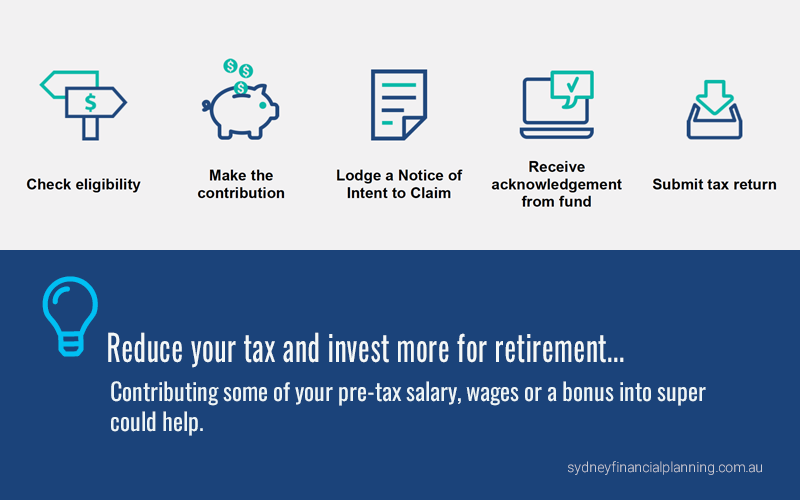You may be eligible to claim a tax deduction if you make a personal contribution to superannuation. There are some important steps you need to follow carefully and specific timeframes to take action.
What are personal deductible contributions?
A personal deductible contribution (PDC) is a voluntary contribution that you make to super on your own behalf and claim a tax deduction in your tax return. These contributions are made with after-tax money, such as your take-home pay or other funds that you might have in savings, such as a bank account. PDCs are generally taxed in the super fund at up to 15%1, instead of your marginal tax rate which could be up to 47%2.
Caps apply which limit the total amount you’re able to contribute to super. Personal contributions ordinarily count towards your non-concessional contribution (NCC) cap. However, if you follow the steps below and claim a tax deduction for some or all of your personal contributions, these amounts will instead count towards your concessional contribution (CC) cap. To find out whether you could benefit from this strategy, you should speak to a financial adviser and a registered tax agent.
Overview on the steps
Step 1:
Check your contribution eligibility and CC cap

Details:
Ensure that directing savings to super is right for you and you are eligible to contribute.
The amount that can be contributed with concessional tax treatment is limited by the CC cap. The general CC cap is $27,500 in 2021/22 and 2022/23.
Your personal CC cap might be higher if you haven’t fully utilised your CC cap each year since 1 July 2018. In this case, you may be eligible to make ‘catch-up concessional contributions’ where certain conditions are met. See ato.gov.au for more information.
Other considerations:
Eligibility to contribute – age limits
If you’re 67-74 at the time you make the contribution, you’ll need to have met a work test for the financial year, or be eligible to apply the work-test exemption.
You cannot make a PDC if you’re aged 75 or older3.
Consider all CCs and timing
Consider what other CCs have been made during the financial year as well as those you’re likely to receive from all sources including employer
contributions and salary sacrifice. It’s important to also consider possible changes to CCs such as additional employer contributions due to a salary increase or bonuses.
If you’re not able to accurately predict your CCs from other sources, you can wait until closer to the end of financial year to make your PDC. You can make more than one personal contribution throughout the year, but be sure to follow all of the steps below to make sure you’re able to claim a deduction for each contribution.
1 If you’re a high income earner and have income from certain sources of more than $250,000 pa, you’ll need to pay an additional 15% tax on your CCs within your CC cap. This is called Division 293 tax. If you’re liable, you’ll receive a notice from the ATO.
2 Includes Medicare levy
3 Contributions must be received no later than 28 days after the month in which you turn 75. Limitations can also apply to other types of contributions, Refer to ato.gov.au for more information.
Step 2:
Make a personal contribution

Details:
Once you’ve worked with your financial adviser to confirm that a PDC is right for you, it’s time to make your personal contribution to your super fund.
Be mindful of your fund’s requirements and timeframes.
Other considerations:
Check cut off dates
If you’re contributing right at the end of the financial year, it is important to check cut-off dates with your super fund to make sure that your contribution is received and allocated to the right financial year.
A contribution is generally ‘made’ when it is received by your super fund which can be different to when you have actioned your contribution (such as via electronic transfer). Therefore, it is important to ensure there is sufficient time for your super fund to receive the contribution in the financial year which you want the contribution to be made.
Check BPay codes
It is also important to check your contribution payment options with your super fund, making sure if you’re using BPay for example, that you use the correct BPay code. Even though a PDC is a CC, you’re making a personal contribution to super which will usually have a different BPay code.
Step 3:
Lodge a Notice of Intent to claim form with your super fund

Details:
The Notice of Intent form notifies your fund that you are going to claim a deduction for all or part of the personal contributions that you’ve made to super.
Tax law requires that this form is lodged within certain timeframes. If you don’t meet this requirement, your notice will be invalid and you’ll be ineligible to claim a tax deduction. Unfortunately your fund has no discretion to waive this requirement.
Other considerations:
Important timing requirements
You must lodge the form with your super fund before the earlier of:
- the day you submit your tax return for the financial year, or
- the end of the following financial year.
For example, for PDCs made in the 2021/22 financial year, you must submit the Notice of Intent to your super fund either before you lodge your tax return for 2021/22, or by 30 June 2023, whichever occurs first.
Step 4:
Receive acknowledgement from the fund

Details:
Your super fund will send you an acknowledgement to confirm that they have received your Notice of Intent form.
Other considerations:
Seek tax advice
An ackowledgement only confirms reciept of a valid Notice of Intent and is not a subsitiute for tax advice. You will need to seek advice from your registered tax agent to claim the deduction in your tax return.
Ensure that you file this letter as you may wish to provide it to your registered tax agent when your tax return is being prepared.
Step 5:
Submit your tax return

Details:
Only after your Notice of Intent is submitted and acknowledgement received should you complete your tax return.
Other considerations:
If you’re late in submitting your tax return
Remember that if for some reason you don’t complete your 2021/22 tax return before 30 June 2023, you’ll still need to make sure your Notice of Intent has been submitted before this date or you won’t be eligibile to claim the deduction.
Step 6:
Make sure steps 3 and 4 are completed before rolling over or withdrawing funds

Details:
You need to ensure you’ve lodged your Notice of Intent and received acknowledgement before you withdraw or rollover some or all of the funds in your super account. This may occur in the same financial year as making the contribution.
If you don’t lodge your Notice of Intent first, you may only be entitled to a:
- partial deduction (if you withdraw or rollover part of your balance), or
- no deduction if you’ve rolled over or withdrawn the full balance.
Other considerations:
If you completed a partial rollover or withdrawal before lodging your Notice of Intent
You’ll need to seek advice from your financial adviser or registered tax agent to determine the reduced amount that you’re able to claim a deduction for. You must submit a valid Notice of Intent for this amount. Your super fund is not a registered tax agent and cannot do this for you.
If you submit a Notice of Intent for the full value of the personal contribution after a parital rollover or withdrawal occurs, the notice is invalid, and you’ll need to follow the above steps to resubmit a valid notice.
Be aware that an automatic rollover that is established to rollover funds periodically to pay for insurance premiums in another super account is a considered a partial rollover. You must ensure that a Notice of Intent is lodged and ackowledged for any contributions made before the rollover occurs during the financial year.
Step 7:
Make sure steps 3 and 4 are completed before you commence an income stream during the year

Details:
If you commence an income stream with any of your account balance before lodging your Notice of Intent and receiving the acknowledgment, you won’t be eligible to claim any deduction for a personal contribution made to the fund during the financial year.
Other considerations:
No discretion available
Once an income stream has commenced using any of the account balance, there is no action that can be taken to rectify this and tax law states that any subsequent notice is invalid. Unfortunately the super fund and the ATO have no discretion to accept a Notice of Intent after the income stream has commenced.
Other important considerations
Change in circumstances
If your circumstances change after you’ve lodged a valid Notice of Intent, you may be able to submit another form to:
- vary down the amount you intend to claim a deduction for (including to nil), or
- notify your fund that you intend to claim a deduction for additional contributions.
Time limits and other requirements apply. This is a complex area and you should seek advice from your financial adviser and/or registered tax agent. ATO denies deduction When you lodge your tax return, you include the value of the deduction for your superannuation contributions that you wish to claim.
However, the ATO will assess your tax return and, in limited situations, may deny your entitlement to the deduction as permitted under the legislation. Generally, this will arise if you don’t have sufficient assessable income to offset the deduction you are claiming after allowing for other tax deductions.
If the ATO denies your deduction, certain steps must be followed which are similar to varying the amount claimed as a tax deduction (see change in circumstances). However, as time limits and other requirements apply, you should seek advice from your financial planner and/or registered tax agent.
If you want to make a PDC and split some of your contributions with your spouse
If eligible, you may be able to split some of your CCs, including PDCs, with your spouse. Generally, you’ll need to wait to lodge a contribution splitting application with your fund until after the end of the financial year in which the contribution was made (unless you’re going to rollover your entire balance to another fund, or withdraw your balance in full, during the financial year). However, you’ll need to make sure that your Notice of Intent has been lodged and acknowledged before lodging your splitting application.
Next steps
Contribution rules and eligibility criteria for catch up CCs are complex. This guide is not designed to provide comprehensive information about how the rules work or apply to you. It is important that you speak with your financial adviser, your registered tax agent and visit the ato.gov.au for more information.
If you aren't sure how to proceed or if you meet the specific criteria...
Speak with one of our Financial Planners about the best approach for your circumstances asap, either book a meeting or get in contact with us on 02 9328 0876.
General Disclaimer: While every care has been taken in the preparation of this document, Sydney Financial Planning and Charter FP make no representations or warranties as to the accuracy or completeness of any statement in it.This article contains information that is general in nature. It does not take into account the objectives, financial situation or needs of any particular person. You need to consider your financial situation and needs before making any decisions based on this information. Please seek personal financial advice prior to acting on this information.








